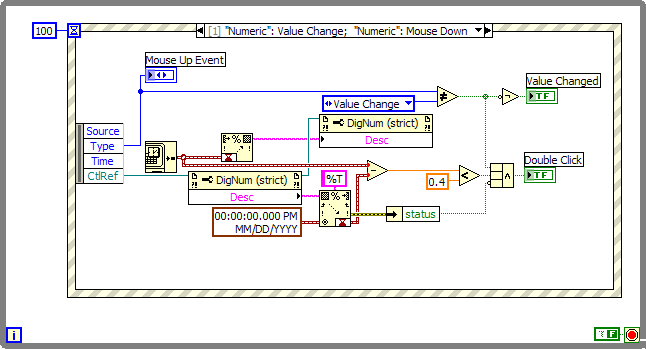-
Posts
466 -
Joined
-
Last visited
-
Days Won
20
Content Type
Profiles
Forums
Downloads
Gallery
Posts posted by viSci
-
-
Anyone every seen one of these puppies? So far I cannot make any headway and will probably need a com port sniffer to pull it off...
-
Actually it would have been nice if execution highlighting revealed the hidden code, but it did not do so in my case.
-
Nice utility, thanks François.
-
I am not able to get the structuresFadeToDiagramBeneath ini to
do anything. Could someone confirm that this works?
-
Greetings one and all, As my first post on the new LAVA site I would like to offer a public service announcement to help others avoid the difficulty I have gone through the past 4 hours. Up until today I found the Auto Grow feature to be annoying and disabled it. But lo and behold it was 2 subvi's hidden in a diagram disable structure that were causing my problem. It occurred to me that this is a nasty pitfall of graphical programming that has always existed prior to Auto Grow. So do yourself a favor and leave Auto Grow Enabled! Perhaps in the future structures could have a simple indication if any objects are outside of its visual boundary.
-
-
Yes, all the methods mentioned do indeed work with cRIO targets. In my system I have 2 9074 targets each with 9144 extension chassis. I am using the scan engine IO Variables which I can read programatically
using Data Socket (DS) and then filter and scale then transfer to my version of the Current Value Table (Fancy shift register based storage) and from there the data is written to a proper NSV library which has a binding to a 'mirror' library on the windows side. From there I cannot via the DSC toolkit to my citadel database.
-
You can also bind one library (say RT target) to a 'mirror' library on another RT or Windows target. LV 8.6 has some nice tools to
help you bind entire libraries. You can also programmatically transfer Network Shared Variable data using Datasocket.
-
The Good News: It is possible to set the initial value of a NSV on an RT target.
The Bad News: There does not seem to be anyway to determine when this initial value is available from the SV server.
For some reason there an initializing period of time that the PSP client (your RT application) needs to connect to the SV server to obtain the
current value of a NSV. You can try looping until the warning message
(Warning -1950679027 occurred at an unidentified location
Possible reason(s):
LabVIEW: (Hex 0x8BBB000D) NI-PSP has not connected to the server yet)
goes away but this does not alway guarantee that the next transaction will be good.
I think NI should provide a utility that can be called that forces this
initialization process to occur.
-
Here's a little utility to deal with the problem.Download File:post-162-1236702011.zip
-
I have noticed in LV 8.6.1 that some of my system numeric 'spinner' controls are no longer accepting min, max data range settings in the data entry popup.
I can type in a new value and it simply reverts to 0. Once LabVIEW has gotten it into its head to do this then all past and future numeric controls will not allow me
to range set. I am guessing that the Numeric Poperties popup has some 'smarts' in it that remembers the last settings and it appears that it is too smart for it own good.
Has anyone else seen this problem? Even worse, is that once a control develops this problem I cannot fix it other than deleting.
-
Cool...I never knew you could get that kind of detailed coordinate information, thanks. I prefer your solution since it does not rely on
having to use up the description property of the controls.
-
Ok, I will try again to explain...If I double click on the text field of the control I want a popup touchscreen keypad to appear. If I click twice rapidly on the up arrow of the control then I do not want to have the keypad popup, but unfortunately the Mods:Double Click property cannot tell the difference by itself. BTW, thanks for your interest in trying to help.
-
Hi Ton,
Perhaps I am not understanding how simple the solution is but I cannot see how to use the native double click to produce the desired result.
Take a closer look at my example and notice that it is able to differentiate, on a single numeric control, between a double click and two fast successive value changes.
-
-
I have an Touchscreen HMI that will popup a keypad when a numeric control is double clicked. The problem is that I also want to allow
a user to single click the inc/dec arrows with the mouse if it is present. If the single clicks are fast enough they register as an unwanted double click event.
I have a single registered mouse down and value changed event for all of the control references in my HMI so I need a generic solution to differentiate between a value change event and a double
click. So far I have not been successful. Is it possible within the value change event to disable the double click event or throw away a mouse click?
-
Ok, thanks for the link to the LV 8.6.1 drivers. Now here is a tougher one...I also need the next rev of the EtherCAT drivers for the 9144 cRIO expansion chassis.
I've looked but can only find the 1.0 version that I already have.
-
Be careful with these LV 8.6.1 installations!!! I foolishly rushed to do this and am getting a niwd4c.dll initialization error in my cRIO RT code. I am guessing that I will need the appropriate NI-DAQ or VISA drivers that will come with the released version of LV 8.6.1. Anybody know were they are hiding?
-
Your connection as indicated is 2-wire. You need to make sure your instrument and the 9871 are both setup for 2 wire auto mode.
-
I have a firewire application that does real time 640x480 with alpha blending and it works very well on a ordinary desktop. LV vision is very fast and powerful, you should
be able to do lots of cool real-time analysis and effects.
Also, keep in mind that you can use any type of firewire camera and do not need the IMAQ frame grabber hardware. Just make sure you have the IEEE 1394 IMAQ drivers.
Please, keep us updated on your progress, perhaps we can share some ideas...
-
This is not your 'fathers' pipe control. It has alot of extra smarts to add connected segments
and has some interesting programmatic features.
-
Does anyone know how this control was created?Download File:post-162-1232549988.ctl
-
I am using a NSV with buffering to send commands from the host PC to one of 2 cRIO's. The cRIO then uses VI Server to make a Remote Call by Reference to a Return Notifier Proxy which completes the transaction. In my stress testing I have yet to miss a transaction with a roundtrip time of ~50-75ms. It appears that the NSV transaction is very fast with the bulk of the
time taken by the Remote Call. BTW, I am caching the Remote Call and NSV Datasocket references.
-
I am using a NSV with buffering to send commands from the host PC to one of 2 cRIO's. The cRIO then uses VI Server to make a Remote Call by Reference to a Return Notifier Proxy on the PC that completes the transaction. In my stress testing I have yet to miss a transaction with a roundtrip time of ~50-75ms. It appears that the NSV transaction is very fast with the bulk of the
time taken by the Remote Call. BTW, I am caching the Remote Call and NSV Datasocket references.


.thumb.jpg.5d2ee2fea691c9fe3fab4270ba8e531d.jpg)

Sola 850 UPS Driver
in Hardware
Posted
Thanks, portmon is awesome! I now have a transcript of the communications protocol which unfortunately is binary but am working on decoding it presently.